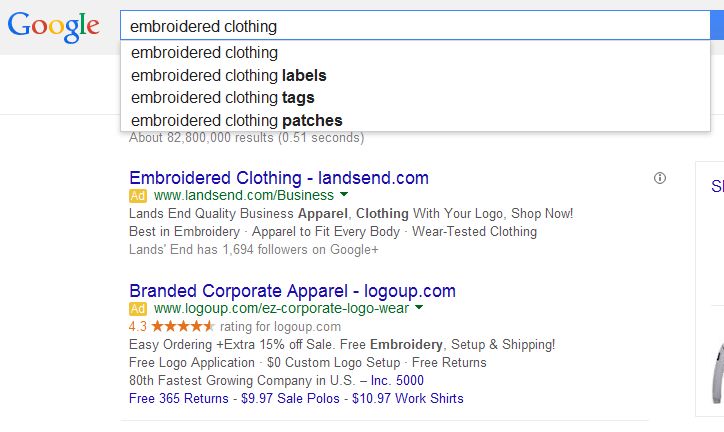SEO for Beginners – Part Two – Keyword Research
Hello again! Welcome to the second installment of our Search Engine Optimization series. If you’ve been following along, you remember that our post last month focused on the basics of website optimization. This month we are going to delve into the basics of keyword research, a very important component of Search Engine Optimization.
Including the right keywords in the content of your website can really make or break your website traffic. For example, the difference in searches between “embroidered apparel” and “embroidered clothing” could be huge, but how do you know? Thankfully, through a little detective work most business owners can determine which keywords their target market is searching for online.
To start, take a minute and create your own list of keywords and keyword phrases that you would search for online to find the products and services that your business offers. Ask a fellow coworker or friend to do the same. Come up with a list of 10-20 keywords. As a general rule, the more keywords in a phrase, the easier it is to rank as theoretically there is generally less competition. For example, “embroidered corporate polo shirt” should be easier to rank for than “embroidered polo”.
Next, take these keywords straight to Google and lets test with their Google Keyword Planner. Yes, this tool is tied to Google’s Adwords platform where you can pay for Google ads, but once you sign up for a free account you can also use the keyword planner to determine traffic volume, keyword competition, and get suggestions for additional keywords.
After you sign up, click on “Search for new keyword and ad group ideas”. After you’ve entered your initial keywords and narrowed by location (if your customers are specific to one area), make sure to toggle over to the “Keyword Ideas” section vs the “Ad Group Ideas” section. At this point you will be able to see search volume, competition for keywords, additional keyword suggestions and suggested bids if you were to pay for ads.
Another Tip! A common mistake when performing keyword research is forgetting to run the numbers for both singular and plural versions of your keywords and keyword phrases. For example, include both “embroidered shirt” and “embroidered shirts” in your list of potential keywords.
An additional quick search you should perform is within Google search page itself as this will provide you with the most commonly searched keywords behind your root terms. For example, “embroidered clothing labels” and “embroidered clothing tags” are most commonly searched after “embroidered clothing”.
For an expanded view, check out ubersuggest. This is a pretty cool tool that will provide you with an overview of commonly typed in Google searches for your keywords.
Once you’ve reviewed the data, you should have a clearer sense of the types of keywords and keyword phrases people are searching for and hopefully you’ll have a handful of new phrases to target in your website content. Make sure to include these keywords in not only your website copy, but in image file names, header tags, and meta tags. You can refer to last month’s blog on website optimization for a full list of suggestions.
A few additional tools that can help with keyword research like SEMrush. These both have some free and some paid features and can help provide a broader overview of the landscape.
We hope you found this installment of our SEO series helpful. As always, if you have any questions please email me, Amy Grishman, at amy@socialfocus.com. Stay tuned for next month’s post where we will continue this series and take a look at the importance of social media marketing in any search engine optimization campaign.
